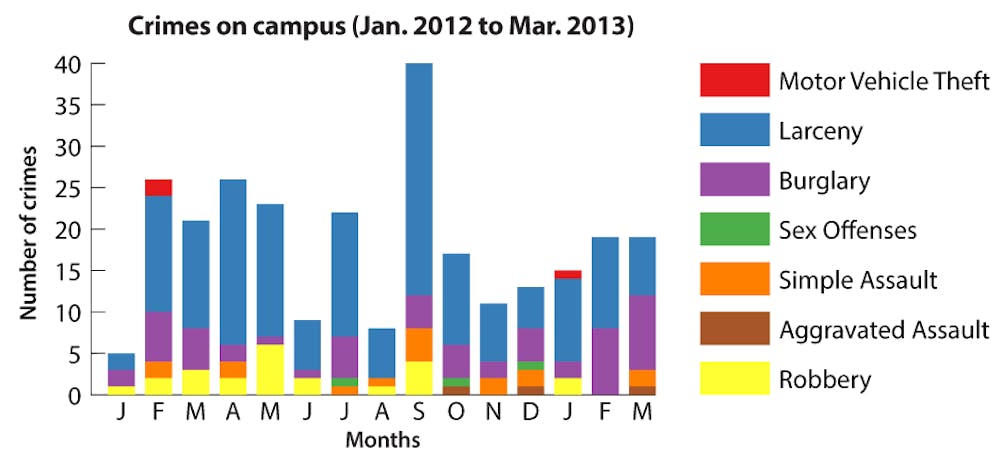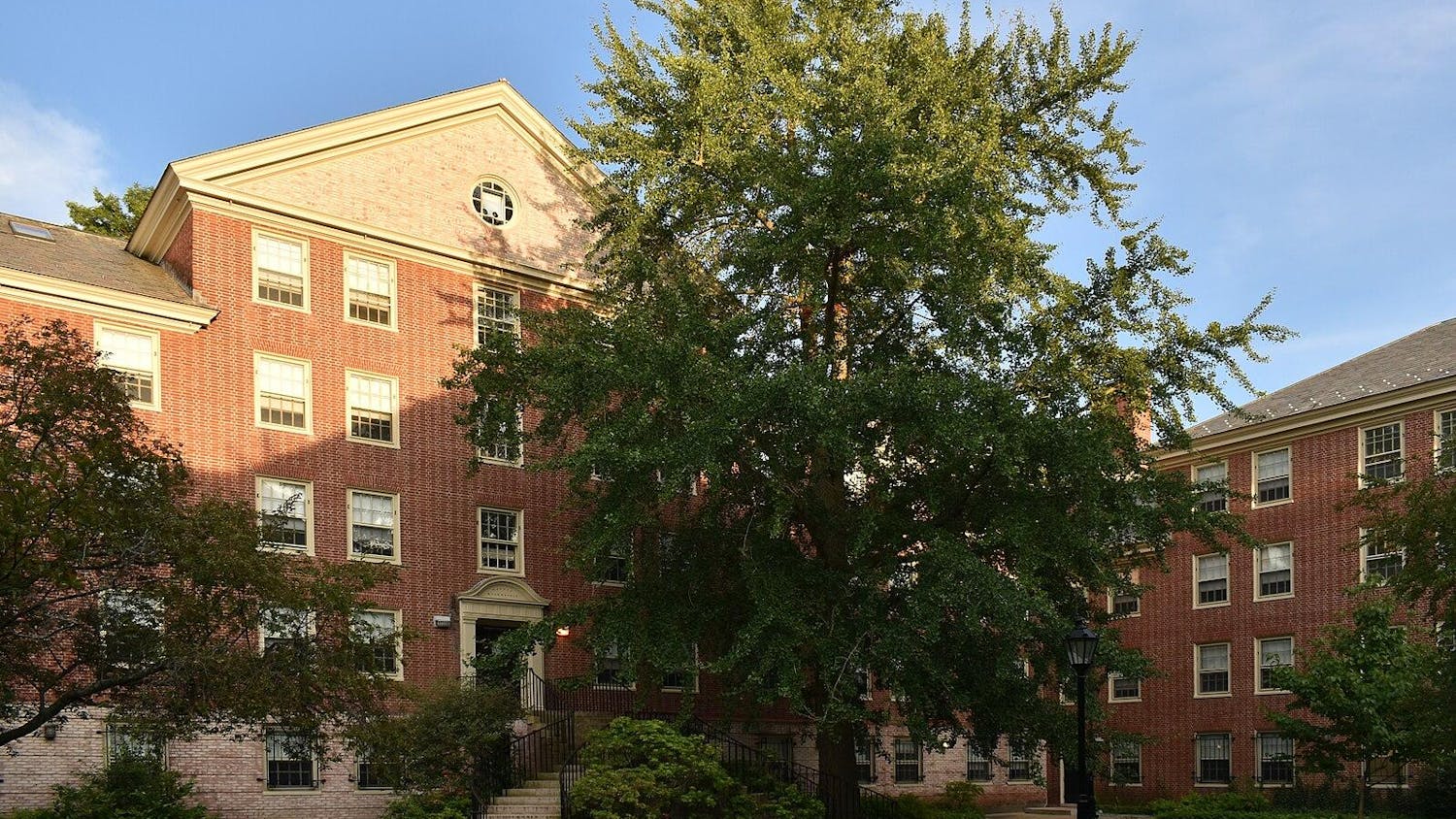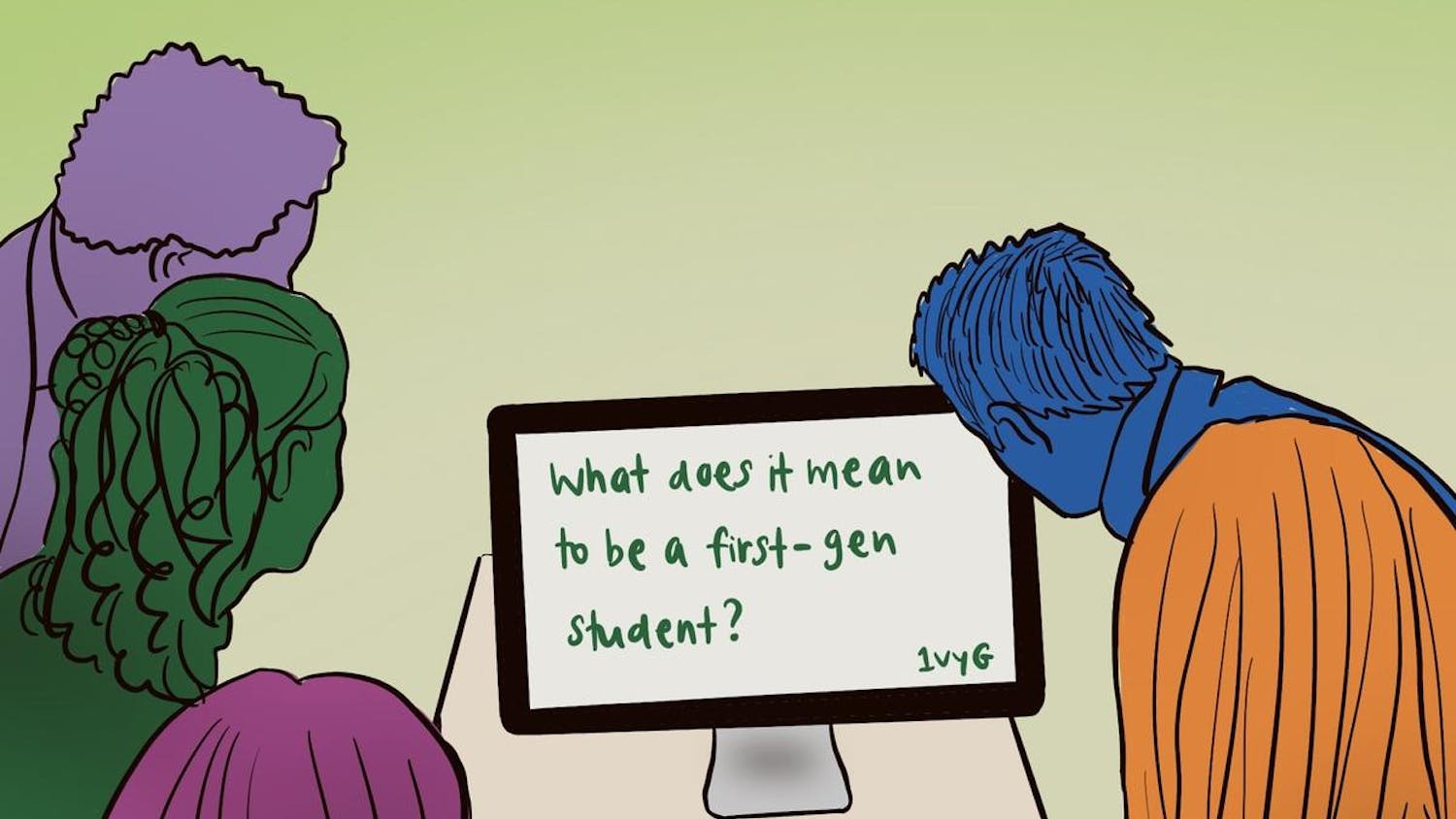A consistent rise in crime throughout 2011 and 2012 — punctuated by 14 robbery cases in the spring of 2012 and prominent incidents of violence — left many students concerned about their safety on campus.
This rise in violent crime prompted the Department of Public Safety to focus on initiatives to combat violent crime, like hiring new officers, increasing officer visibility on campus and parterning with Facilities Management employees to increase oversight of residence halls.
But numbers released at a recent meeting of the Public Safety Oversight Committee revealed dorm thefts comprise the majority of on-campus crimes, while violent robberies have declined.
Staying off the streets
Stories of late-night muggings by suspects wielding weapons are often more highly publicized than other forms of crime, and students said their foremost fears center on walking alone after midnight. But recent crime trends suggest instances of violent crime are declining.
Many students said they feel scared when walking around campus after dark.
A spike in violent street crime on campus through 2011 and early 2012 fueled these fears. There were only five robberies in 2009, but that number more than doubled to 11 in 2011 and doubled again to 22 in 2012.
Alyssa Browning ’15 said she “walks with fear looming over her head” when traveling alone at night.
“The scariest time of day or night is probably between 4 and 5 (a.m.) because the only people that are up at that time are probably up to no good,” said Woody Rosenberg ’13.
Andrew Little ’16 was assaulted and robbed outside the Gate in January. Four assailants followed Little through campus, stole his coat, backpack and cell phone, punched him and stomped on his head, sending him to the hospital with a broken jaw.
Stories like Little’s and last year’s spike in violent crime augment widespread student fear of walking at night, though the DPS reports show a decrease in violent crime on College Hill this semester. Incidents of robbery involving force or threat of force have dropped significantly this academic year, with two instances in the last six months, compared to eight incidents over the same months in the 2011-12 school year, according to DPS crime reports.
Cases of laptop thefts not involving force or confrontation occur at a far greater frequency, with 21 incidents in the last three months, compared to nine in those months last year. Incidents of burglary and breaking and entering are up 46 percent this year compared to last, an indication that thefts are occurring more often in student residences than on the street.
Much of the growing number of laptop thefts and burglaries stem from factors like open doors in residence halls and “crimes of opportunity,” said Paul Shanley, deputy chief of DPS.
When students prop doors open for weekend parties in dorm rooms, individuals who are not Brown students enter the halls, Shanley said, noting that many of this year’s cases resulted from these situations.
Unlocked dorm rooms also allow for easy access to valuables and further increase the number of burglaries, Shanley said. Two-thirds of laptop thefts this year have occurred in residence halls with no signs of forced entry to the halls or rooms, according to the reports.
DPS frequently cannot recover laptops stolen from unlocked dorm rooms due to a lack of visible evidence and witnesses, Shanley said. Students whose laptops were stolen said police officers told them they would review surveillance footage when available. Four of the 21 laptops stolen this year have been recovered, according to the reports.
Visible progress
This semester’s drop in robberies and “midnight mugging” incidents stems from DPS programs emphasizing officer visibility, Shanley said.
Some DPS initiatives have seen more success than others, and certain programs have taken on new functions outside the realm of safety.
After the number of robberies peaked at 21 in the first nine months of 2012, DPS officials looked to combat the upward trend through increased street presence. The department added six new officers to its staff in 2011 and received approval from the University Resources Committee to hire four more in the fall, The Herald previously reported.
DPS also partnered with the Department of Facilities Management in January to help officers observe and prevent potentially dangerous encounters, Shanley said. DPS officers now meet regularly with Facilities Management employees — who “are in the buildings most often and know if something is out of place” — to discuss signs of suspicious activity, like broken door handles or unknown individuals in dorms, he added. “They may see a door that was damaged or they see someone that doesn’t seem right, and they’d give us a call.”
Increased officer presence has yielded more arrests in robbery cases. DPS has apprehended suspects in five of the six cases this year, compared to only four out of 13 cases in spring 2012.
Safewalk and safeRIDE — programs intended to give students safe means of travel around campus at night — remain the most well-known and frequently-utilized DPS efforts, but both draw students for reasons other than safety.
Most students who use Safewalk are upperclassmen looking to socialize — not frightened students looking for protection, said Safewalker Onyebuchi Udozorh ’14.
Benjamin Flakoll ’16 cited cold temperatures as the reason he uses safeRIDE regularly, while Emma Suchland ’16 said she uses the service for convenience.
“The use of safeRIDE is not always about safety, although we do encourage the community to take advantage of the program as a safety measure,” wrote Elizabeth Gentry, assistant vice president for financial and administrative services, who helps oversee safeRIDE in the Transportation Office, in an email to The Herald.
Any time a student rides the shuttle for any reason, it “alleviates a potential for crime,” she wrote.
Establishing relationships
Many students do not realize how much their perception of DPS affects the department’s ability to respond to incidents and conduct investigations, Shanley said, adding that as a result, department officials have placed extra emphasis on student relations in recent years.
Students used to seeing DPS officers around campus are more likely to call when they need help, Shanley said. The number of service calls the department receives can be an indicator of students’ trust in its officers, he added.
In the first three months of 2013, DPS received 15.7 percent more service calls than in the same period in 2012, according to the reports.
“If (students) are not telling us what is going on, we’re kind of in the dark,” said Lionel Butterfield, a DPS security officer who patrols campus to help students who have locked themselves out of their rooms and provide students and staff members with information on campus activity.
Students and officers build good relationships through day-to-day interactions on the street, Butterfield said.
“It takes a certain type of person to be campus officer,” he said. “It’s about developing relationships with students — it’s not about kicking ass and taking names.”
DPS has also tried to use its Facebook and Twitter presences to reach out to students.
Students said they base their views of DPS on officers’ performances on the job rather than on department initiatives. Most of those interviewed said they are satisfied with DPS and its coverage, citing officers’ fast response times and consistent follow-up with victims as contributing to the department’s reputation.
“DPS is very good at taking care of crime immediately on campus,” said Daniel Podlisny ’14.
Mary Sketch ’15 said she was impressed with the speed and extent of DPS’s response after her laptop was stolen from her room in December while she was asleep.
“They were really quick to respond,” Sketch said. “I was talking to a lot of different detectives that day, which was very helpful.” She added that DPS placed a security guard in her hall as an extra precaution the night after the incident occurred.
Little gave DPS a “10 out of 10” for its response after he was assaulted. “The second I reported anything (DPS) came … They were very nice to me, they brought me to court and have been very supportive.”
Other students voiced concerns about campus lighting and the extent of DPS’s off-campus presence. Officers “make a big effort to prevent things and keep their students safe, though I never quite understand why the Main Green and Lincoln Field are so poorly lit,” Browning said.
While there are “guards in a lot of places” on campus, Podlisny said there is little security presence off campus except for “an occasional Providence police officer.”
“I feel like there is this invisible wall around Brown’s campus,” Rosenberg said, adding that once a student steps beyond campus borders, he is no longer as safe.
- Additional reporting by Kiera Peltz

ADVERTISEMENT




